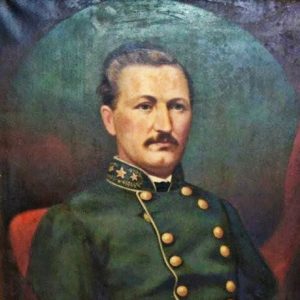calsfoundation@cals.org
Henry Byrd (1805–1884)
Henry Byrd was one of Arkansas’s most prolific antebellum portrait painters. His portraits present Arkansas’s merchants, planters, and professional gentlemen, along with their wives and children, as they wished posterity to see them.
Henry Byrd was born in Ireland in 1805, one of seven children born to William Byrd and Anne Garrett of Belmount Hall, County Tiperary. He immigrated to America and was naturalized through the port of New York City in November 1835. He established himself as a painter and resided at 164 Delancy Street in New York City.
During his years in New York, Byrd married Sarah J. Updike, and they had two children while still in New York. Sometime during the late 1830s, the family migrated south, appearing in New Orleans circa 1839. The newspapers recognized the newly arrived artist almost from the beginning. In 1841, the Picayune described an elaborate display containing two full-length portraits by Byrd. Unfortunately, no portraits from this period of Byrd’s work have been formally identified. Hundreds of paintings attributed to Byrd hang in private homes and public buildings, but for some unknown reason, Byrd seldom signed his paintings. As of 2010, there are only two known signed paintings.
Having attained success in New Orleans, Byrd first presented himself to the Arkansas public through a card in the Arkansas Gazette on August 4, 1841, announcing that he was available at the Anthony House, a local boarding house. His family was undoubtedly traveling with him, as his daughter Mary was born in Little Rock (Pulaski County) on August 21, 1841.
Byrd next appeared in Batesville (Independence County) and found a congenial home among the residents, making long-lasting friendships. In May and June 1843, the Arkansas Gazette called attention to Byrd three times, praising his work extravagantly. He was thereafter known as the premier portrait painter of Arkansas, his popularity never flagging. In spite of his success, 1843 was not a good year for Byrd. He was forced to file for bankruptcy in February, and the final report was filed in August, declaring him a “discharged bankrupt.” He was cleared of his debt but was allowed to keep only his household furniture and the tools of his trade. Further adding to the trials of the following years, his wife died on May 30, 1845.
In 1850, when Byrd was forty-six years old, he married Leinad Speers, a fellow Irish immigrant who was only seventeen years old when she married him. They had six children, and the family prospered, settling in El Dorado (Union County). Here, Byrd acquired properties and business lots and, most likely, was a business partner in the drugstore of J. B. Speers and Co., which occupied one of Byrd’s buildings (J. B. Speers being Byrd’s brother-in-law).
At the outbreak of the Civil War, Byrd was too old for military service, but his name appears on an undated list for equipping the Union County Regiment for Confederate service. His firstborn son, a member of Colonel Thomas Dockery’s Nineteenth Arkansas Infantry, died at the Battle of Vicksburg in 1863.
On October 9, 1867, Leinad died, and Byrd soon moved back to New Orleans, taking his five sons and one daughter with him. On March 3, 1870, he married Elizabeth Fairchild. The marriage ended in divorce after a few months. In 1873, he married Rosa Keiser, with whom he had two children. He settled in suburban Carrollton and began to reestablish himself, appearing in city directories from 1867 to 1883. In 1866, the New Orleans Times reported that Varina Howell Davis had visited Byrd’s studio to see three paintings of Jefferson Davis, her husband. She pronounced them to be about the most correct portraits of him that she had ever seen.
Henry Byrd died in Carrollton on September 26, 1884. He painted until the end, completing one of two life-sized self-portraits only two weeks before his death.
For additional information:
Bennett, Swannee. Arkansas Made: A Survey of the Decorative, Mechanical, and Fine Arts Produced in Arkansas, 1819–1870. Vol. 2. Fayetteville: University of Arkansas Press, 1991.
Gossett, Ryan R. “Henry Byrd—Early Portrait Painter.” Ouachita County Historical Quarterly 56 (Spring 2025): 6–11.
Hudson, Ralph M. “Art in Arkansas.” Arkansas Historical Quarterly 3 (Winter 1944): 299–350.
Klopfenstein, Philip A. “John Henry Byrd.” Jefferson County Historical Quarterly 4.4 (1973): 4–12.
Robert Byrd
Gainesville, Florida
 Dockery Portrait
Dockery Portrait  Fent Noland
Fent Noland 



I wonder if the portraits of Jefferson Davis have ever been published. I have four unsigned family portraits that have been identified as Byrd portraits.